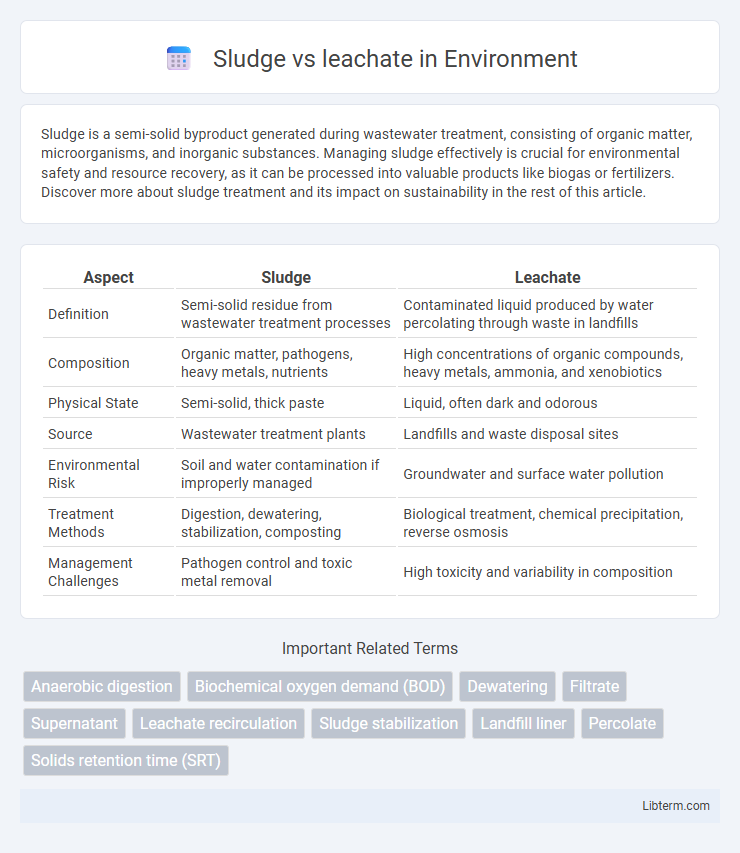Sludge is a semi-solid byproduct generated during wastewater treatment, consisting of organic matter, microorganisms, and inorganic substances. Managing sludge effectively is crucial for environmental safety and resource recovery, as it can be processed into valuable products like biogas or fertilizers. Discover more about sludge treatment and its impact on sustainability in the rest of this article.
Table of Comparison
| Aspect | Sludge | Leachate |
|---|---|---|
| Definition | Semi-solid residue from wastewater treatment processes | Contaminated liquid produced by water percolating through waste in landfills |
| Composition | Organic matter, pathogens, heavy metals, nutrients | High concentrations of organic compounds, heavy metals, ammonia, and xenobiotics |
| Physical State | Semi-solid, thick paste | Liquid, often dark and odorous |
| Source | Wastewater treatment plants | Landfills and waste disposal sites |
| Environmental Risk | Soil and water contamination if improperly managed | Groundwater and surface water pollution |
| Treatment Methods | Digestion, dewatering, stabilization, composting | Biological treatment, chemical precipitation, reverse osmosis |
| Management Challenges | Pathogen control and toxic metal removal | High toxicity and variability in composition |
Introduction to Sludge and Leachate
Sludge is a semi-solid byproduct generated during the treatment of wastewater, consisting of organic and inorganic materials, microorganisms, and chemical residues. Leachate refers to the highly contaminated liquid produced when water percolates through waste in landfills, containing dissolved substances such as heavy metals, organic compounds, and nutrients. Understanding the composition and treatment challenges of both sludge and leachate is essential for effective waste management and environmental protection.
Defining Sludge: Origins and Characteristics
Sludge originates from the solid residues generated during wastewater treatment processes, consisting primarily of organic matter, microorganisms, and inorganic materials. It exhibits a semi-solid texture with high moisture content and contains concentrated pollutants such as heavy metals, pathogens, and nutrients. The composition and characteristics of sludge vary depending on the source of wastewater and the specific treatment methods employed.
What is Leachate? Formation and Composition
Leachate is a contaminated liquid generated when water percolates through waste materials in landfills or sludge deposits, absorbing soluble substances and organic compounds. Its formation involves the infiltration of precipitation or surface water, which interacts with decomposing waste, resulting in a highly variable chemical composition that includes heavy metals, organic matter, ammonia, and pathogens. Understanding leachate composition is crucial for designing effective treatment systems to prevent environmental pollution and protect groundwater resources.
Key Differences Between Sludge and Leachate
Sludge consists of semi-solid waste material generated during wastewater treatment processes, rich in organic matter and solids, while leachate is the liquid that drains or 'leaches' from landfill waste, containing dissolved contaminants and heavy metals. Sludge typically requires dewatering and stabilization before disposal or reuse, whereas leachate demands intensive treatment to prevent groundwater pollution due to its high toxicity and complex chemical composition. The main difference lies in their physical state and origin: sludge is a byproduct of water purification processes, whereas leachate originates from landfill waste decomposition and percolation of precipitation.
Sources: Where Do Sludge and Leachate Come From?
Sludge primarily originates from wastewater treatment plants where solids settle out during the treatment process, including organic matter, chemicals, and microorganisms. Leachate is generated from landfill sites when rainwater percolates through waste, dissolving contaminants and producing a toxic liquid mixture. Both sludge and leachate contain hazardous substances, but their sources and formation mechanisms are distinctly tied to wastewater management and solid waste decomposition, respectively.
Environmental Impact: Sludge vs Leachate
Sludge, a semi-solid byproduct of wastewater treatment, can cause soil and water contamination if improperly managed, releasing pathogens and heavy metals into the environment. Leachate, a toxic liquid generated from landfill decomposition, poses significant risks to groundwater due to its high concentrations of organic compounds, heavy metals, and ammonia. Effective containment and treatment of both sludge and leachate are essential to minimize adverse environmental impacts and protect ecosystems.
Treatment Methods for Sludge
Sludge treatment methods primarily include thickening, digestion, dewatering, and stabilization processes to reduce volume and enhance biodegradability. Anaerobic digestion is a widely applied treatment that produces biogas while stabilizing organic matter in sludge. Mechanical dewatering techniques like centrifugation and belt filter presses help remove excess water, facilitating easier disposal or further processing of sludge.
Treatment Approaches for Leachate
Leachate treatment approaches primarily involve physical, chemical, and biological processes to remove contaminants and reduce toxicity. Advanced treatments include membrane filtration, such as reverse osmosis, and biological methods like activated sludge and constructed wetlands for organic load reduction. Chemical treatments, including coagulation-flocculation and advanced oxidation processes, further enhance leachate quality by removing heavy metals and recalcitrant compounds.
Regulatory Considerations for Sludge and Leachate Management
Regulatory considerations for sludge and leachate management emphasize compliance with environmental protection standards under the Clean Water Act and Resource Conservation and Recovery Act (RCRA). Sludge management must adhere to regulations on land application, treatment, and disposal to prevent soil and groundwater contamination, while leachate control requires strict monitoring and treatment protocols to avoid hazardous substance discharge into water bodies. Effective regulatory frameworks mandate permits, regular reporting, and implementation of best management practices to minimize ecological and public health risks associated with both waste streams.
Future Trends in Sludge and Leachate Treatment
Future trends in sludge and leachate treatment emphasize advanced biological methods such as anaerobic digestion and microbial fuel cells to enhance resource recovery and energy production. Emerging technologies integrate membrane filtration and electrochemical oxidation to improve contaminant removal efficiency and reduce environmental impact. Digital monitoring and AI-driven process optimization are gaining traction for real-time operational control and predictive maintenance in wastewater treatment facilities.
Sludge Infographic

 libterm.com
libterm.com